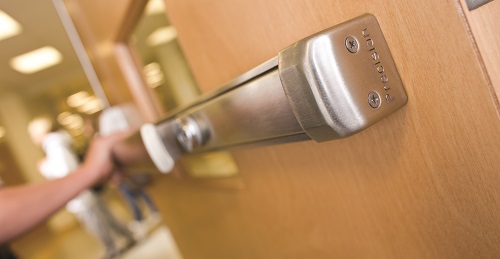877-412-3667 9AM - 3PM CST
ORDERS OVER $200 SHIP FREE - CONTINENTAL US ONLY
877-412-3667 9AM - 3PM CST
ORDERS OVER $200 SHIP FREE - CONTINENTAL US ONLY
Have you ever heard someone refer to "dogging a door" and wondered what it meant? The term "dogging" actually has its origins in the mechanical workings of older style commercial doors. Let's take a closer look at what it means to dog a door and why the term is still used today.
Dogging a door refers to the act of holding the latch bolt or push bar in the open position to allow for unrestricted access in and out of the door. This is typically achieved through the use of a small metal plate, called a dogging plate, that is installed on the door and held in place with a thumbturn or hex key.
The term "dogging" comes from the early days of commercial doors when a mechanical device, called a "door dog," was used to hold the door in an open position. These door dogs were often made of cast iron and were designed to slide into a slot in the door frame to hold the door open. The term "dogging" was later used to describe any method of holding a door open, regardless of the type of hardware used.
There are several benefits to dogging a door, particularly in high-traffic areas. By holding the door open, it allows for easier passage in and out of the door, which can improve traffic flow and reduce congestion. This can be particularly important in emergency situations where quick exit is necessary. Additionally, it can be helpful in situations where hands-free access is needed, such as when moving large items through the doorway.
Today, dogging a door is typically achieved through the use of a dogging plate and thumbturn or hex key, as mentioned earlier. This allows for easy and quick access to the door when needed, while also allowing the door to be secured when necessary. Dogging plates are available in a variety of styles and finishes to match any door hardware, and can be easily installed on most commercial doors.
The term "dogging a door" may have its roots in the early mechanical devices used to hold doors open, but it is still a relevant term in the world of commercial doors today. By understanding the origin and benefits of dogging a door, you can make informed decisions about the type of hardware you need for your particular application.


Email [email protected] or call 877-412-3667 with the product you are interested in, the quantity, and any other requirements you may have. One of our specialists will email you back a free quotation shortly. Did you know we offer free design help? If you are unsure of the product you need, but know the scope of what function or application you need, our design team can help! Contact us with your inquiry today.
